Research on IoT and EVs for UCLA Anderson Technology Management: Cloud Computing & Big Data (440–9)
Executive Summary & Key Findings
- Investments in smart city infrastructure and autonomous vehicles will have big social and economic benefits, including:
- Enhanced urban mobility
- Improved citizen and social care
- Strengthened public safety by faster response times for ambulance, fire and police emergency services
- Increased city and local business revenues
- Cloud computing solution providers have developed technology frameworks to drive adoption by autonomous mobility providers and city infrastructure planners.
- 5G and new data streams from IoT infrastructure will enable innovative business models with opportunities to monetize data by both municipal and private entities.
- There is little agreement about standards, critical to connecting autonomous vehicles, humans, robots, and drones so they can coexist in smart city infrastructure.
- Siloed smart city infrastructure data will result in failure to uncover the full potential of IoT and AI for cities
*Cited works at the end.
Recommendations
- Focus on a future where technology delivers more than convenience. Use innovation to create emotional connections, strengthen relationships and expand social networks
- Maximize data value — leaders must learn more than the basics of IoT and Cloud in order to build a better future, cities and happier citizens.
- Share digital objects and data across city and government. departments, and build digital twin models. Infrastructure data sharing is critical for innovation and value creation for citizens.
- Some infrastructure data should be available to the private sector to maximize consumer value and drive commerce for local businesses. Strike a balance between thoughtful utility and personalized targeting, to avoid uncomfortable feelings of privacy invasion
Introduction to Smart City v2
More than half of the world’s population lives in our cities today, with another 2.5B expected to be added by 2050. Cities rely on digital infrastructure and intelligence to address the growing demand from residents to deliver a better quality of life, efficient mobility, reduce crime, cleanliness and even social connectedness. With better data, cities can operate more efficiently, and become more productive places to do business.

Many cities have begun upgrading their infrastructure with IoTs and sensing technologies to manage and optimize their municipal assets, including public transportation, utilities, and roads. Connected infrastructure provides for real-time data and analytics that is translated into efficient city operations and cost savings. For example, sensors can report anomalies in asset performance and schedule pre-emptive maintenance, so those who live, work, and visit the city are rarely inconvenienced.
During the 2019 Singularity Summit Naomi Yee shared Magic Leap’s Smart City Livability Pillars, many of which are discussed in this paper.
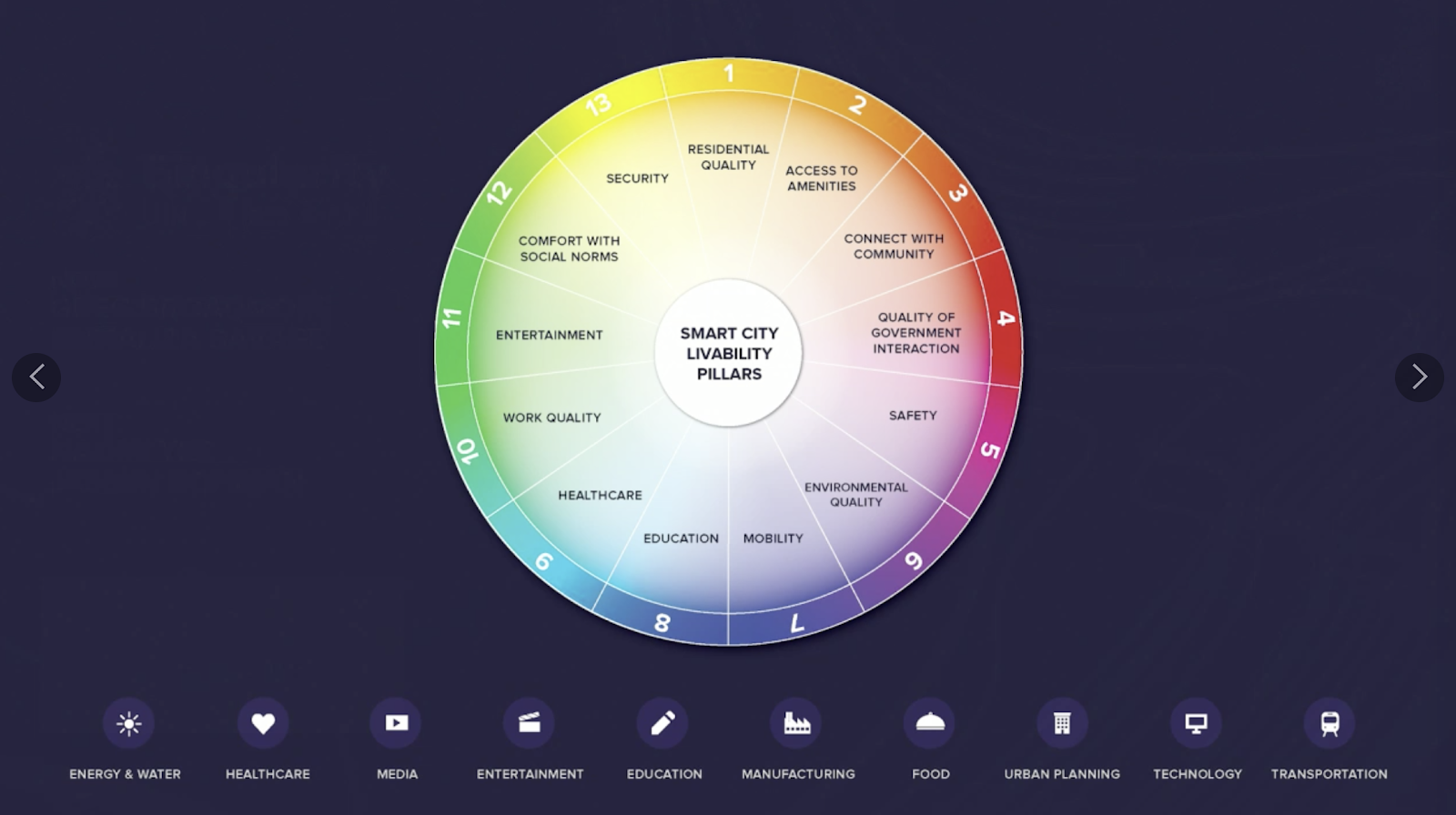
Why is Smart City Mobility Important?
The importance and impact of efficient urban mobility, including public transportation, is clearly visualized in the photos below, demonstrating the space needs when moving the same number of people by bus, bikes, and cars:
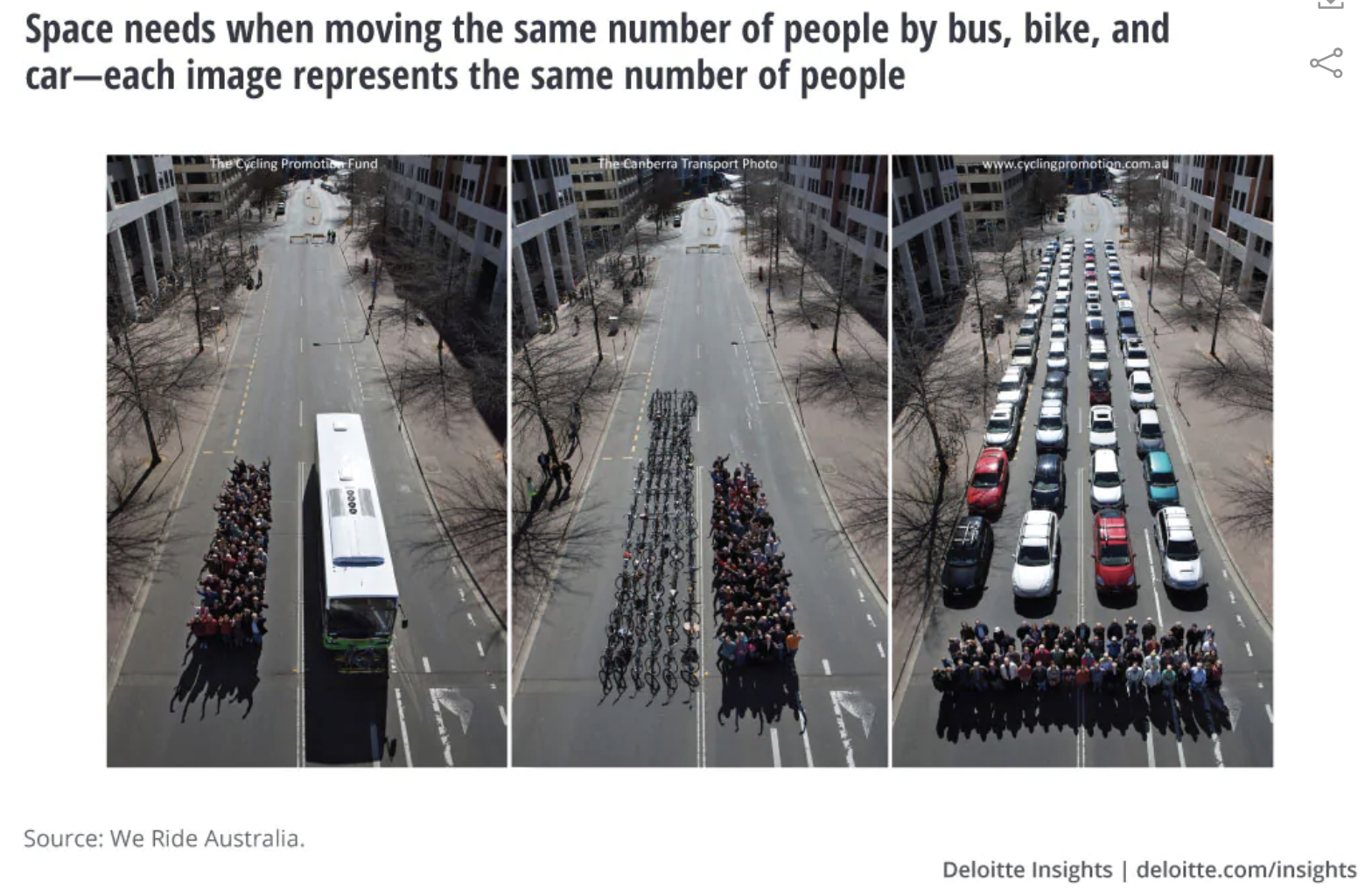
What are the elements of Smart City Mobility?
When planning for an all-inclusive smart city mobility infrastructure, the following areas must be considered and planned together:
- Real-time public transit information
- Digital public transit payment
- Autonomous vehicles
- Predictive maintenance of transportation infrastructure
- Intelligent traffic signals
- Congestion pricing
- Demand-based micro-transit
- Smart parking
- E-hailing (private and pooled)
- Car sharing
- Bike sharing
- Integrated multimodal information
- Real-time road navigation
- Parcel load pooling
- Smart parcel lockers

Public Transportation
Public transportation systems comprise of distributed networks of small independent vehicles, buses, shuttles, trains, and trolleys. The full transportation network of the city must be connected, issuing reliable and updated information which would ideally enable a person to plan and synchronize mobility across all. With 5G wireless connectivity, the public transit system will reduce rider wait times while also optimizing vehicle inventory. Giving transit operators minute-by-minute information on the number of users who are currently using the system, or who intend to use the system at a specific time, will help increase system utilization, and allow for dynamic bus routing.
Electric Shuttles
Some of the less obvious application for such shuttles are:
- Scalable. Daisy-chain (or platoon) multiple shuttles to accommodate demand volume
- Virtualized stops and pick-up zones. Flexible and digitally managed based on time of day, special circumstances or traffic
- Time efficiency. Shuttle-passenger connectivity enables time-saving and time-certainty due to fewer stops and more efficient routes
- Culture and real-life social networking enhanced via technology
- More socially responsible and efficient than single person ride-hailing
- Personalized and contextually relevant. Recommendations and offers “near me” or “on my route”
- Sync and Go. Sign-in and calendar integration for recommendations based on available time
- Social. Who’s on board feature for real-life social networking
- Easy destination inputs via calendar integrations, saved locations, direct address or on-map inputs
- Digital Nudges. Real-time shuttle connectivity guides passengers when to start walking for timely boarding and destination arrival
- Schedule and skip rides, departure count-downs.
- Rate trips, report cleanliness, repair needs, accidents or inappropriate behaviors
- Trigger an emergency stop or make a 911 call
5G enabled Technology Integrations
For a electric shuttles, there is a lot of opportunity to enhance to rider experiences by connecting productivity, collaboration, and entertainment services.
- Branded Voice Virtual Assistant. Use voice commands for various functions including environmental control, questions for a virtual assistant, suggestions and notifications
- Office 365 & MS Teams Experiences. Use Office 365 and Teams for Business for various functions and purposes including creating, editing, viewing and sharing documents, viewing contact lists, text, chat, voice calls, and/or joining meetings
- Xbox Experience. Use of Xbox for content, music, and potentially gaming through Xbox subscription services
- Facial and Voice source recognition to personalize responses
Local Motors’ Olli
At the 2019 Singularity University Global Summit, CEO John Rogers introduced the Olli, a 3D printed mobility solution manufactured in local “Microfactories.” The platform John is proposing is called “agile hardware”, with the ability to make continuous hardware and software upgrades. What’s fascinating is that the tires themselves have no air, and all technology sits in the tire, and not in the frunk, creating more room for passengers and enabling innovative designs not constraint by hardware placement requirements.
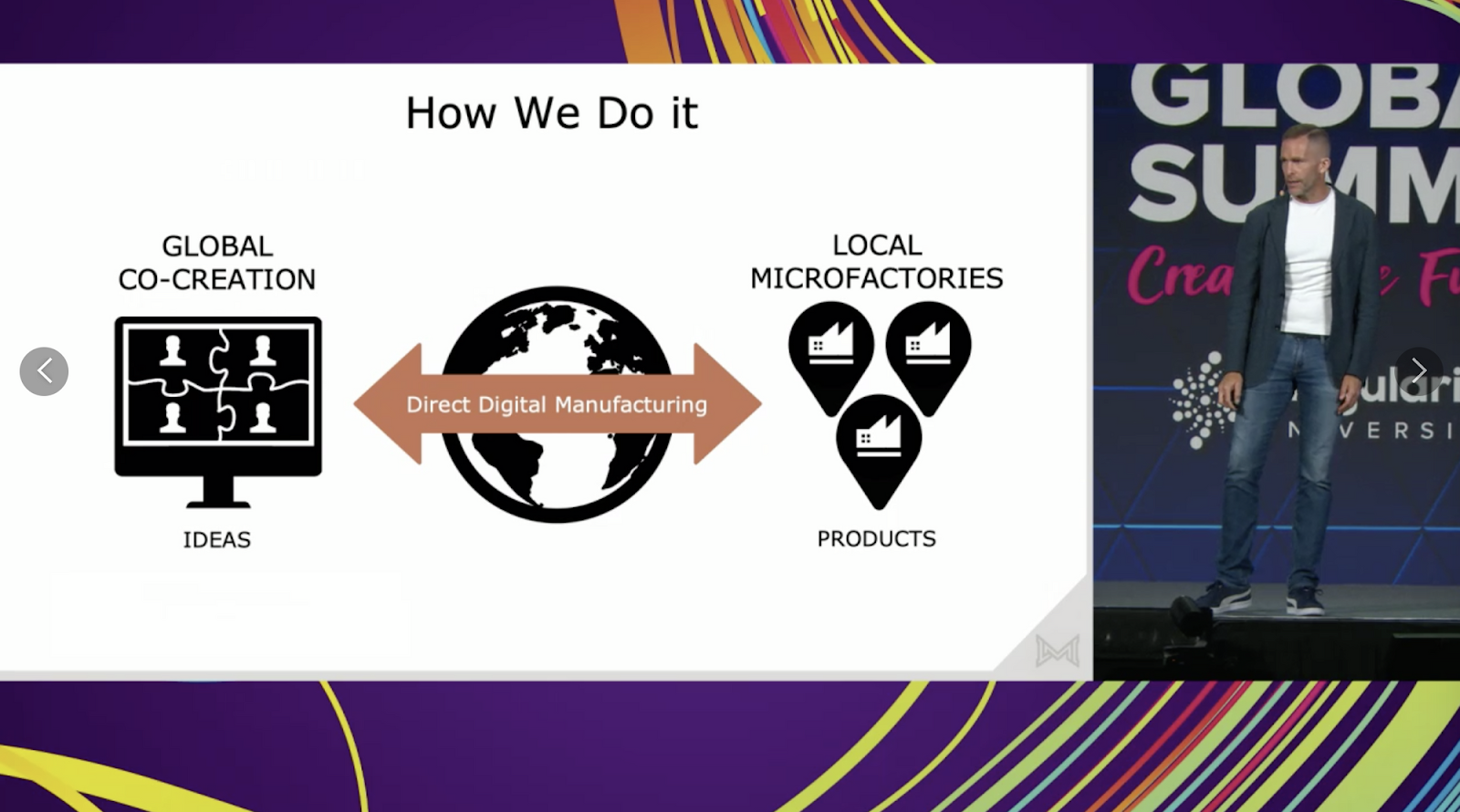
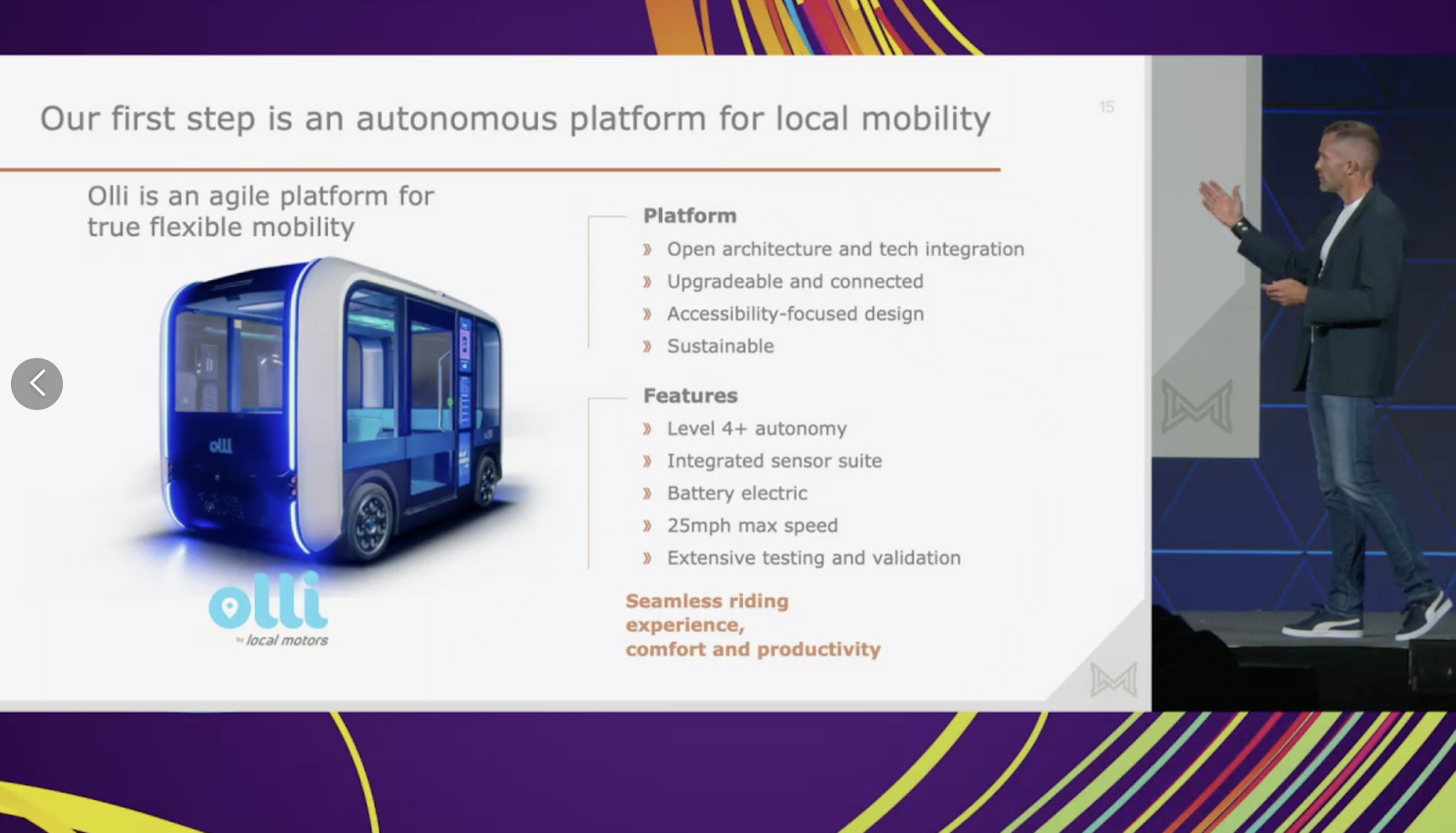

To continue to improve the AI, the Olli sends a continuous operational data stream such as how many times a stuart intervene and for what reason, how many turns, stops, etc. it takes for parts to fail in order to build up predictive maintenance models.

Olli’s Micro-Factory Production Model
John’s mobility vision is based on a Microfactory production model defined as “a forward-deployed physical space connected to a global platform for co-creation.” These micro-factories are a place for rapid product development, modular experimentation, and small-batch manufacturing of products. To break even, a micro-factory needs to produce 200 units, compared to the industry standard of 20,000.
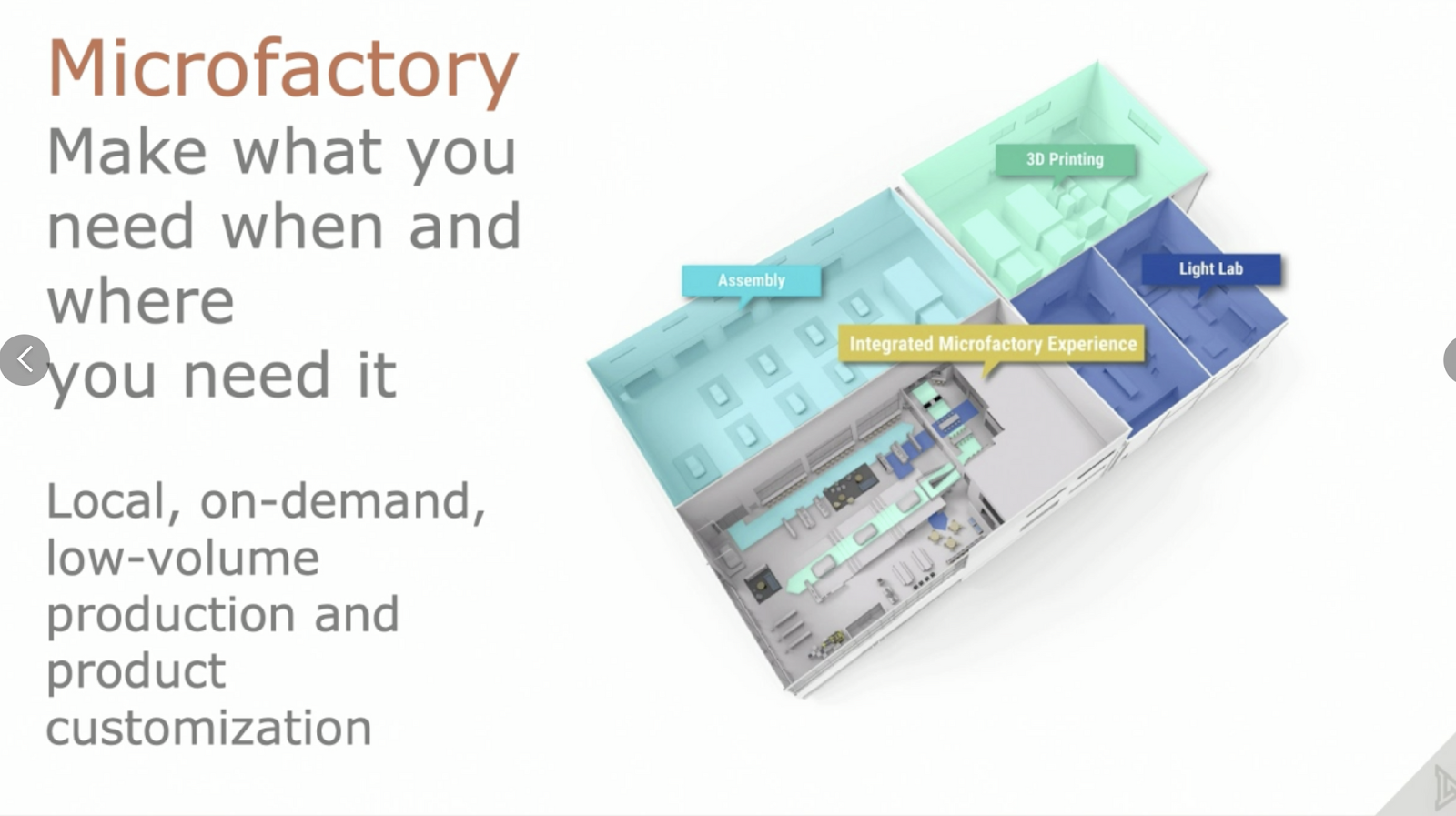
What’s desirable about this approach is the small production footprint. Mobility micro-factories can be setup anywhere, including your home town, and thus improving local economies. The Singularity 2019 keynote video mentioned the following benefits:
- Printable vehicles in 9h
- Advances of Manufacturing
- Faster manufacturing lead time
- 80% 3D printed with 100% recycled material
- 90% fewer parts than a traditional vehicle
- Modular Building Block Construction
- Direct digital manufacturing requires 40% less energy
- Customization and Localization with less investment
- Profitable production scales down to 200 units, vs 20,000
- Crash Pulse Similar to EOM
- Local Job Creation
Increased Asset Uptime via defect prevention with predictive maintenance
Asset uptime is critical for city mobility, and connected mobility solutions to a larger operational framework can improve utilization of assets. Microsoft’s Azure Machine Learning framework can predict failures before they happen with real-time assembly line data. This solution is built on the Azure managed services: Azure Stream Analytics, Event Hubs, Machine Learning Studio, SQL Data Warehouse and Power BI. These services run in a high-availability environment, patched and supported, allowing you to focus on your solution instead of the environment they run in.

Traffic Management

It is estimated that traffic congestion can be reduced by 40%, saving drivers and operators in medium-sized cities approximately $100 million annually. Thanks to 5G’s ultra-fast speeds, cars will be able to “convoy” or “platoon” in groups, increasing road vehicle capacity, while providing substantial energy savings for vehicle owners. And if autonomous cars are supported by Smart Traffic Management systems, congestion could decrease and deliver additional productivity and quality-of-life improvements to residents.
According to Accenture, 5G can contribute to an additional 25% of fuel saving in smart car convoys by improving the safe distance between vehicles with V2V communications.

Smart Parking + Metering
The real-time availability of empty on-street parking spaces will lead to increased parking revenue by 27% due to vehicles no longer needing to circle the block, and instead go directly to an open space. Making available parking spot data available helps reduce vehicle congestion and idling, and drive foot traffic to local businesses.
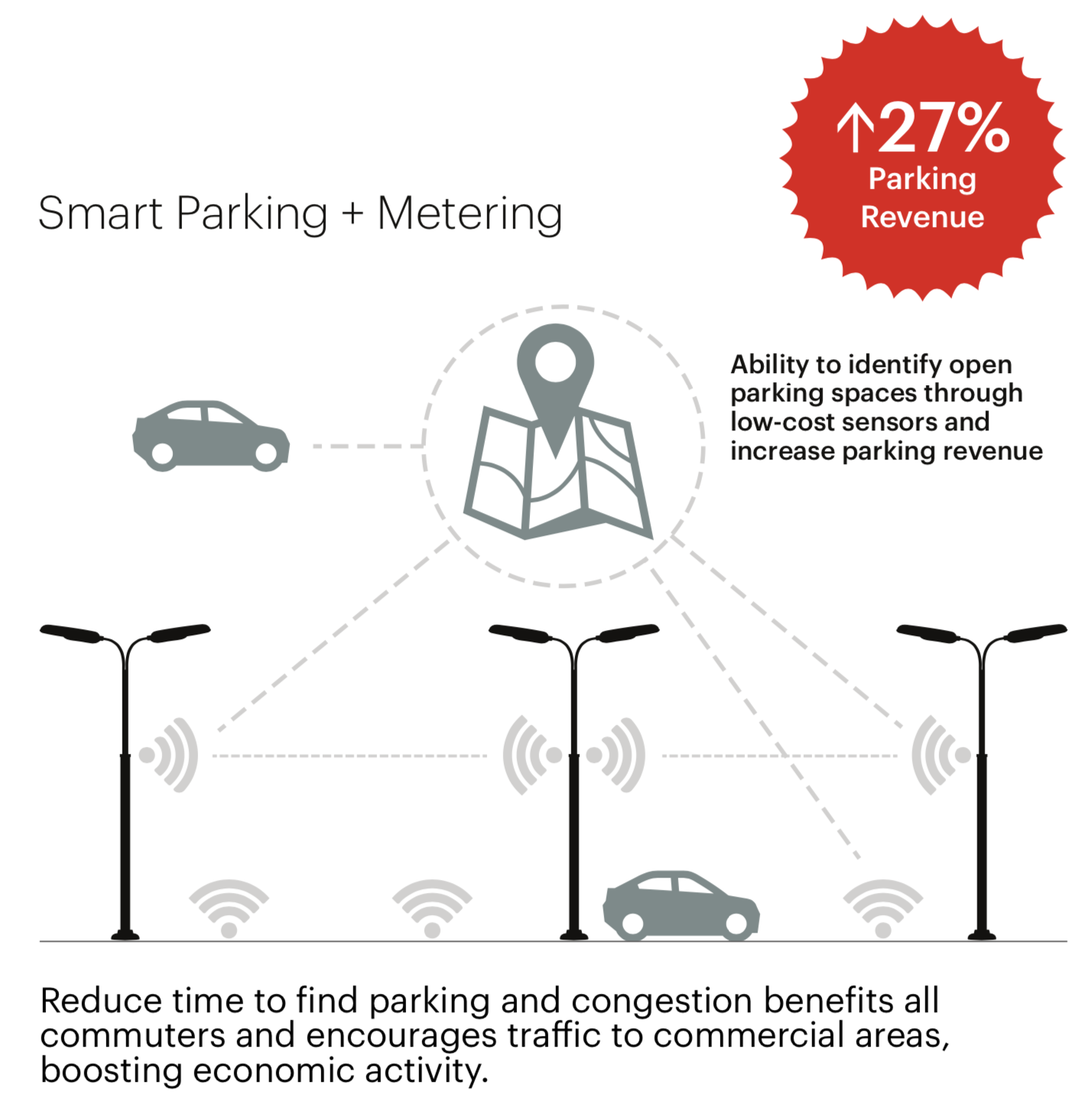
Smart Lighting
Sensors and connected IoT infrastructure can reduce city operating costs by automatically dimming public lighting when no pedestrians or vehicles are present. Smart lighting saves power and reduces light pollution while still keeping neighborhoods safe. This technology is already being rolled out in cities such as San Diego and Barcelona, with San Diego projected to save an estimated $1.9 million annually. Across the U.S., the potential savings from this approach are estimated to be more than $1 billion per year.
Safety
Amazon and Microsoft have built up a suite of services designed for compliment first responder services and prevent crimes. The clever implementation of IoTs data, and connections to first responders allow for unprecedented response times and value to city residents. Below is a sample of Amazon’s smart city technologies:
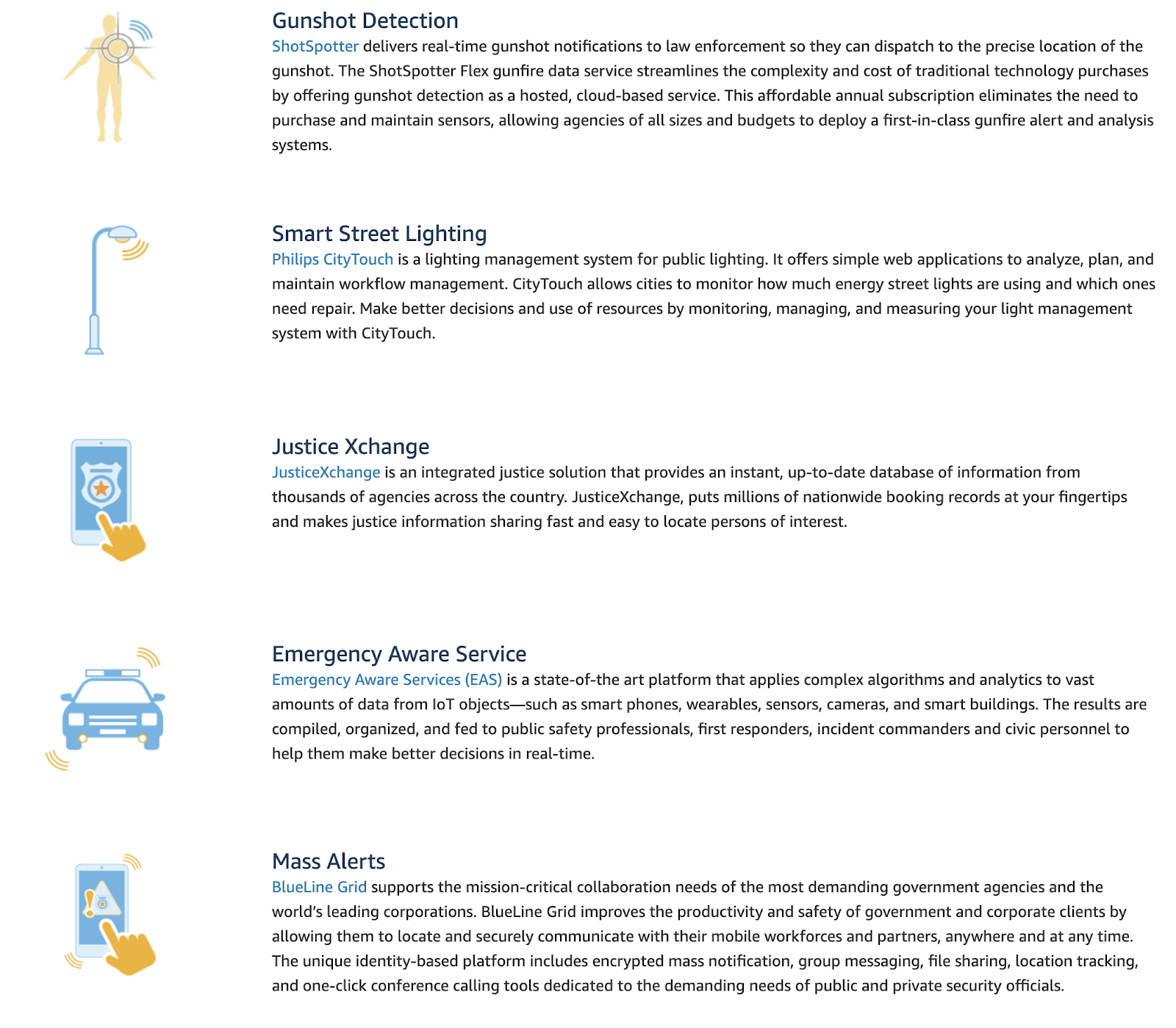
Crime Prevention
Microsoft, Uber and other technology giants are using Knightscope K5 autonomous patrolling robots, combined with analytics and engagement, to predict and prevent crime. Predictive analytics can better focus city resources and reduce response times for citizens.
Gun Shot Detection
Currently, cities like Chicago rely on real-time video feeds over 4G to assess a scene before first responders are dispatched. 5G will elevate video feeds to high definition which will enable facial recognition to ID known criminals or missing persons. Wireless sensors help San Francisco to immediately generate detailed, real-time, location-based information when a firearm is discharged. This allows authorities to be immediately alerted, and has helped reduce gun crime by up to 50% in neighborhoods where the technology has been deployed. When a gun is fired, the sensors can triangulate the location, and sometimes even identify the type of gun. That information is sent to authorities to speed up deployment of personnel to the location. Accenture has estimated that this technology has reduced gun crime by up to 50%.
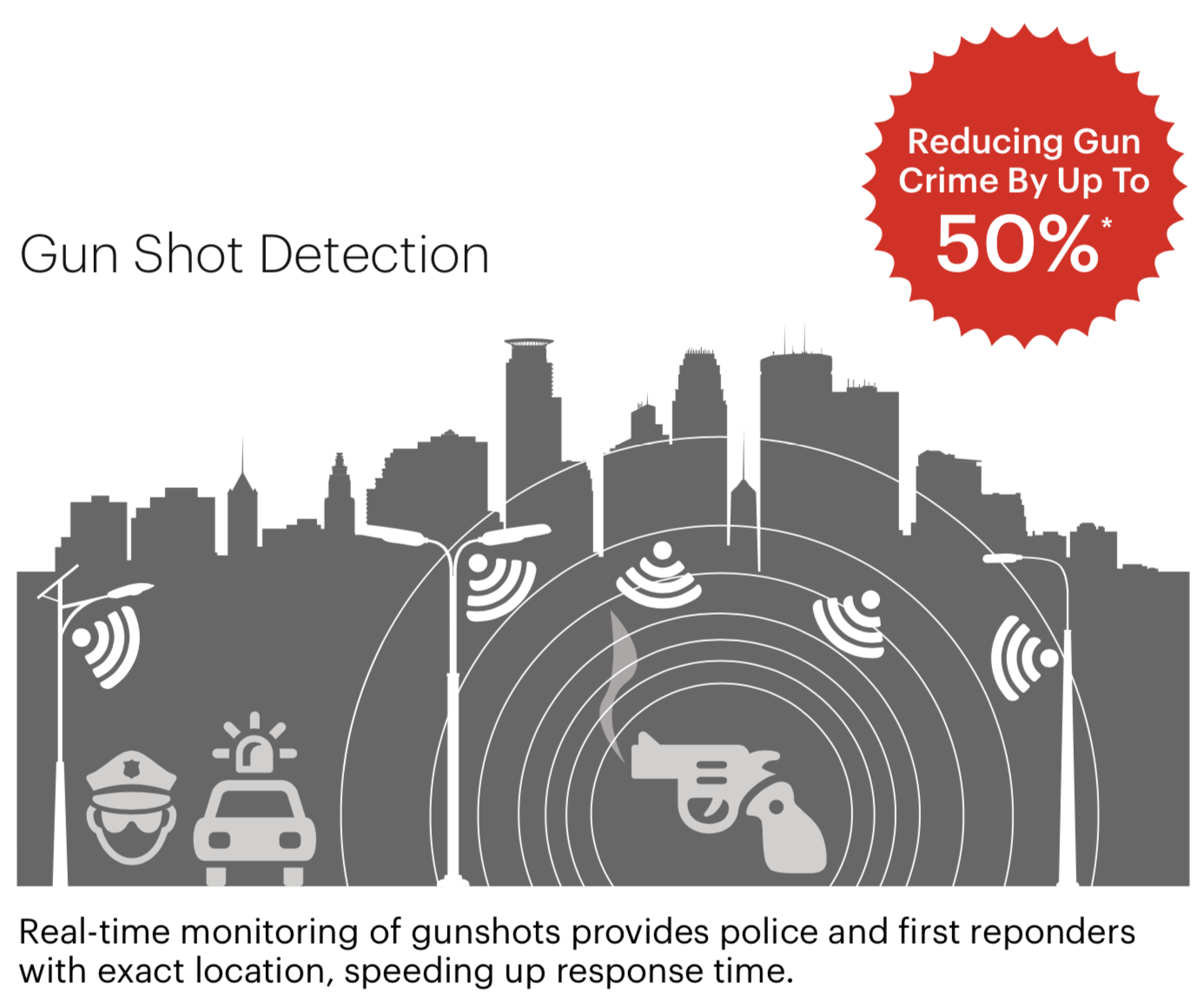
Autonomous Vehicles
The most challenging adoption of fully autonomous vehicles will be during the transition period of coexistence with non-autonomous vehicles.
For the entire ecosystem to function, autonomous vehicles must also integrate with smart city infrastructure. Svetlana Sicular from Gartner writes: “Such vehicles use various onboard sensing and localization technologies, such as lidar, radar, cameras, GPS and map data, in combination with AI-based decision-making, to drive without human intervention. The main implications of self-driving vehicles will be in the economic, business and societal dimensions. Automotive and technology companies will be able to market autonomous vehicles as having innovative driver assistance, safety and convenience features, as well as being an option to reduce vehicle fuel consumption and improve traffic management. These systems offer an ideal platform for the consumption and creation of digital content, including location-based services, vehicle-centric information and communications technologies.”
Deloitte’s infographic below nicely summarizes an imaginable use case of an autonomous vehicle planning an optimal path, saving the passenger time, while driving local business.

Fully autonomous vehicles are referred to as Level 5, well defined by Masatsune Yamaji as “self-driving vehicles that can operate without human intervention in every situation and condition. As a result, there is no longer any requirement for a vehicle to be fitted with pedals, brakes or a steering wheel. The autonomous vehicle system controls all driving tasks. They will have even farther-reaching consequences for the transport and logistics industries, which will no longer require human drivers. Different activities can be undertaken while the vehicle is in motion, while road safety will improve. This may lead to a relaxation of certain safety laws, allowing the vehicle interior to be rethought. As a result, people will seek to utilize their time in a vehicle more productively. This will lead to the vehicle becoming the third living space, where people engage with family and friends, watch videos, play computer games, and work. There is even the potential for autonomous vehicles to lead to services such as haircuts or massages being delivered while in transit between locations, and workouts being undertaken in a vehicle as part of a daily commute.”
The adoption of autonomous vehicles will transform the city workforce because more people will be willing to commute longer distances. Employees can use travel time for work or entertainment while being driven in an autonomous vehicle, living near a city center to be close to work will become less critical and slow the process of urbanization.
Technology that enables autonomous things is rapidly maturing with investments in autonomous vehicle technology startups tripling between 2016 and 2017, and continued to increase through 2018. By 2025, more than 12% of newly produced vehicles will have autonomous driving hardware capability of SAE Level 3 or higher.
Engaging Consumers in Transit
With consumers no longer having to focus on driving, new opportunities for productivity, activity and entertainment will emerge to engage consumers while they are on the go but not focused on driving. Vehicles will feature modular interiors, embedded screens, collaboration technologies and connectivity to connect them with the outside world.

Deloitte nicely puts the power of 5g in context: “5G deployment will make connectivity an increasingly complementary part of the autonomous vehicle ecosystem. LTE has limits on the number of devices that can be provisioned on a mobile network. However, the massive device density 5G delivers allows for 1 million connections per square kilometer.”
Autonomous Connected Vehicle Technology Stack
McKinsey & Co. summarizes the autonomous mobility tech stack and how it extends beyond connectivity and autonomy.

Amazon’s Autonomous Vehicle Development
Amazon has already built a tremendous amount of infrastructure to make it easy for OEMs to adopt their connected vehicle platforms. AWS’ highly scalable storage and compute services and advanced deep learning frameworks allow for the collection, ingestion, storage and analysis of autonomous vehicle data to support full-scale autonomous vehicle development.

In addition, Amazon has developed infrastructure for vehicle applications using AWS’ serverless, microservices based approach and the security of AWS IoT platform, allowing automotive companies to easily build and scale connected vehicle applications at low cost.
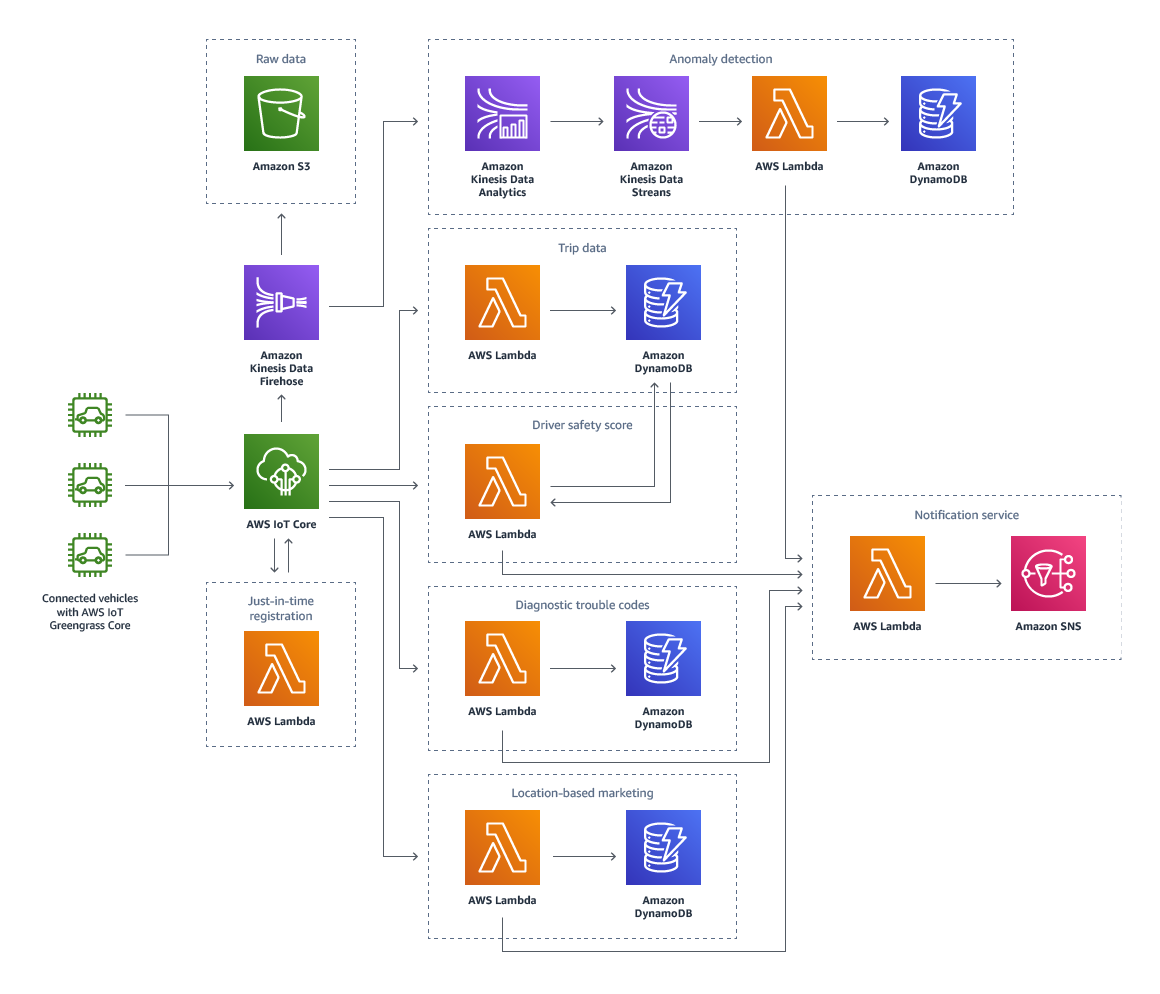
Microsoft’s Connected Car Vision
In 2017 Microsoft published a white paper outlining their Connected Vehicle Platform, consisting of a comprehensive set of Microsoft services and products that span the physical (car) and digital (cloud), with a focus on addressing commonly required use cases. These include telematics and predictive services, productivity and digital life, connected advanced driver assistance systems (ADAS), advanced navigation, and customer insights and engagement. “This connected car environment creates a path to safer, higher quality products, expands revenue opportunities, and is a catalyst for other advances, such as optimized ride-sharing, autonomous driving, and V2X (vehicle-to-vehicle, vehicle-to-infrastructure, vehicle-to-pedestrian, vehicle-to-anything) technologies.”


Since 2017 Microsoft has continued to build up its connected vehicle platform. The below diagram shows how their cloud architecture for car dealerships, manufacturers, and insurance companies can use Microsoft Azure to gain predictive insights on vehicle health and driving habits. This solution is built on the Azure managed services: Event Hubs, Azure Stream Analytics, Machine Learning Studio, Storage Accounts, HDInsight, Data Factory, Azure SQL Database and Powe
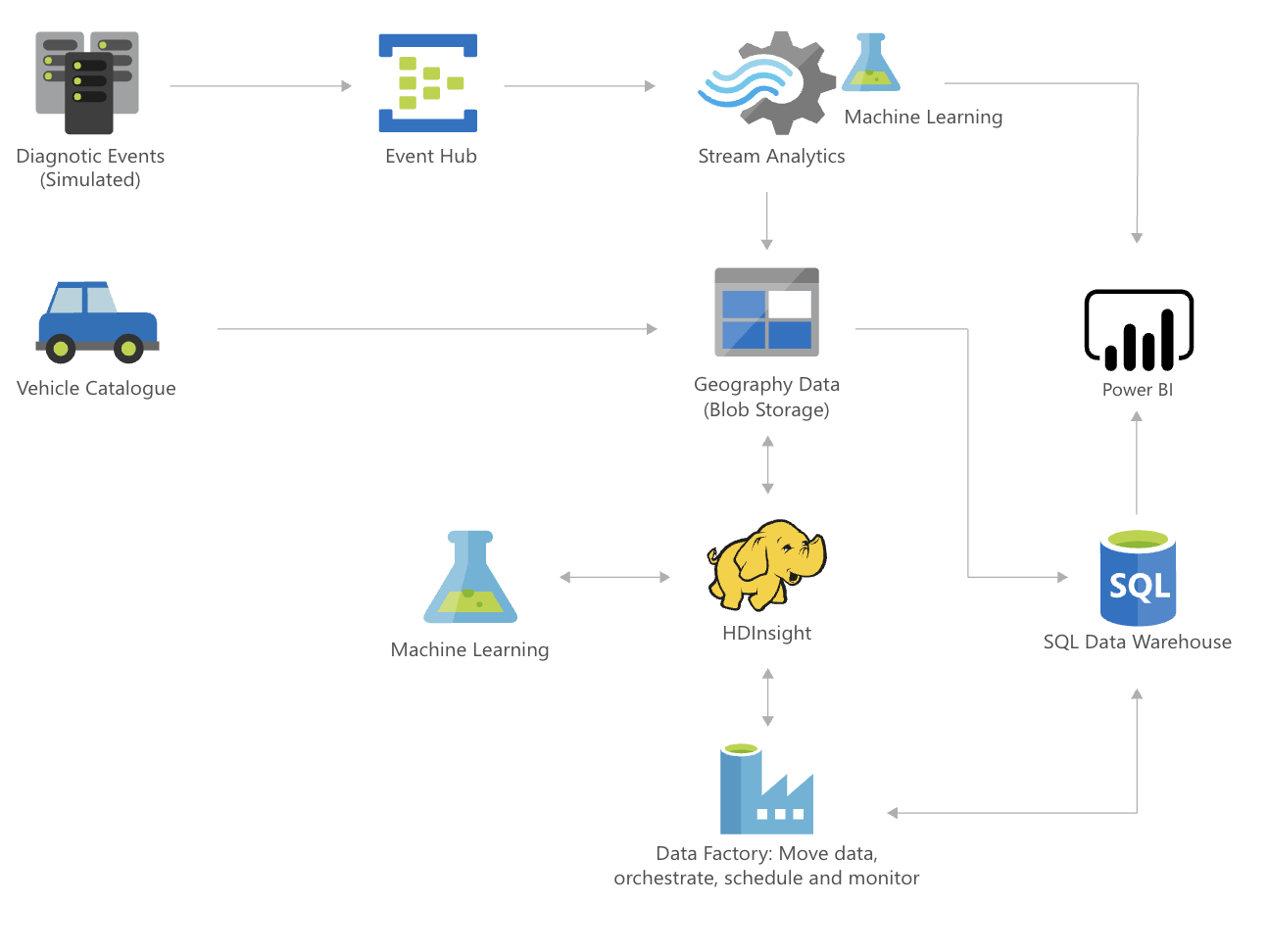
Telemetry Analytics
Microsoft’s Cortana Intelligence is a fully managed big data and advanced analytics suite that enables transformation of vehicle data into intelligent action. The Cortana Intelligence Vehicle Telemetry Analytics Solution Template (below) demonstrates how car dealerships, automobile manufacturers and insurance companies can use the capabilities of Cortana Intelligence to gain real-time and predictive insights on vehicle health and driving habits.

Such data can be used for predictive maintenance and product improvements.
Autonomous Mobile Structures (AMSs)
Rarely talked about are autonomous mobile structures — mini “buildings” that can relocate themselves without human attention. Roger Williams at Gartner describes AMSs as:
“Food trucks and mobile health units can be considered precursors to AMSs. As autonomous vehicle technology matures, the split between buildings and vehicles will break down. AMSs will create new possibilities for disruption of all industries through infrastructure sharing, enabling greater personalization and localization of services. Personal services that require specialized equipment could now be used at home. Resources that are rarely needed can be acquired just in time and shared with others when not in use… AMSs will change society because they blur the lines between buildings and vehicles. Many other lines of business are using vehicles to deliver services. Blood donation, grocery shopping, workout facilities, birthday party hosting, massage therapy, pet care and mobile phone repair are just a few examples of services being delivered in this manner.

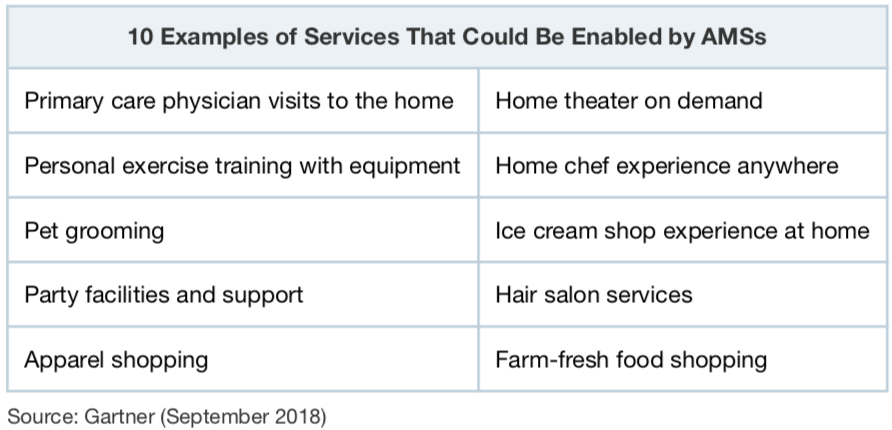

Autonomous Delivery Robots
Unlike other parts of the supply chain, the last-mile sector has seen little technological disruption. Urban delivery robots face many challenges including deliveries to apartment complexes. However, some consumers have reported they’d prefer to drop a pin of their preferred pick up location and accept delivery from the robot in person. Walmart will begin trials of autonomous grocery deliveries in Arizona. It plans to roll out 360 autonomous robot floor cleaners that will navigate around people and obstacles. Walmart is also trialing autonomous robot scanners in Tampa, Florida, that will relieve workers from scanning inventory and prices.
“Over the next few years, self-driving vehicles will transform the last mile, making it cheaper to make deliveries and easier to receive them.” — Brian Wilcove, a partner at Artiman Ventures and investor in Boxbot
Legislation to make self-driving robots legal on the sidewalks in the district of Columbia and Virginia has already passed, with similar laws in the works in Florida and Idaho. That said, some cities, including San Francisco, have banned testing robots on sidewalks. Delivery robots are yet another mobility solution that must integrate into an all inclusive smart city infrastructure.
Autonomous UAVs & FAVs
Commercial unmanned aerial vehicles (UAVs), also known as drones, are small helicopters, fixed-wing airplanes, multirotors and hybrid aircrafts that have no human pilot on board. They are either man controlled / navigated, or via autonomous technology. Companies like Amazon are experimenting using drones for commercial purposes such as last-mile deliveries.
Flying autonomous vehicles (FAVs) are self-operating aircraft, sometimes called “flying cars.” While the technology is many years out, Boeing, Airbus, Volocopter and EHang are testing FAVs now.
As smart cities integrate more and more autonomous vehicles, adding flying vehicles will further increase the complexity of managing all objects, and the need for connectivity standards and 5G.
V2X: Connecting Vehicles to Smart City Infrastructure and Humans
It is easy to imagine how multiple autonomous systems and layers of data can result into chaos without data connectivity and sharing between vehicles. According to McKinsey & Co. a new ecosystem is beginning to coalesce comprised of the following elements:
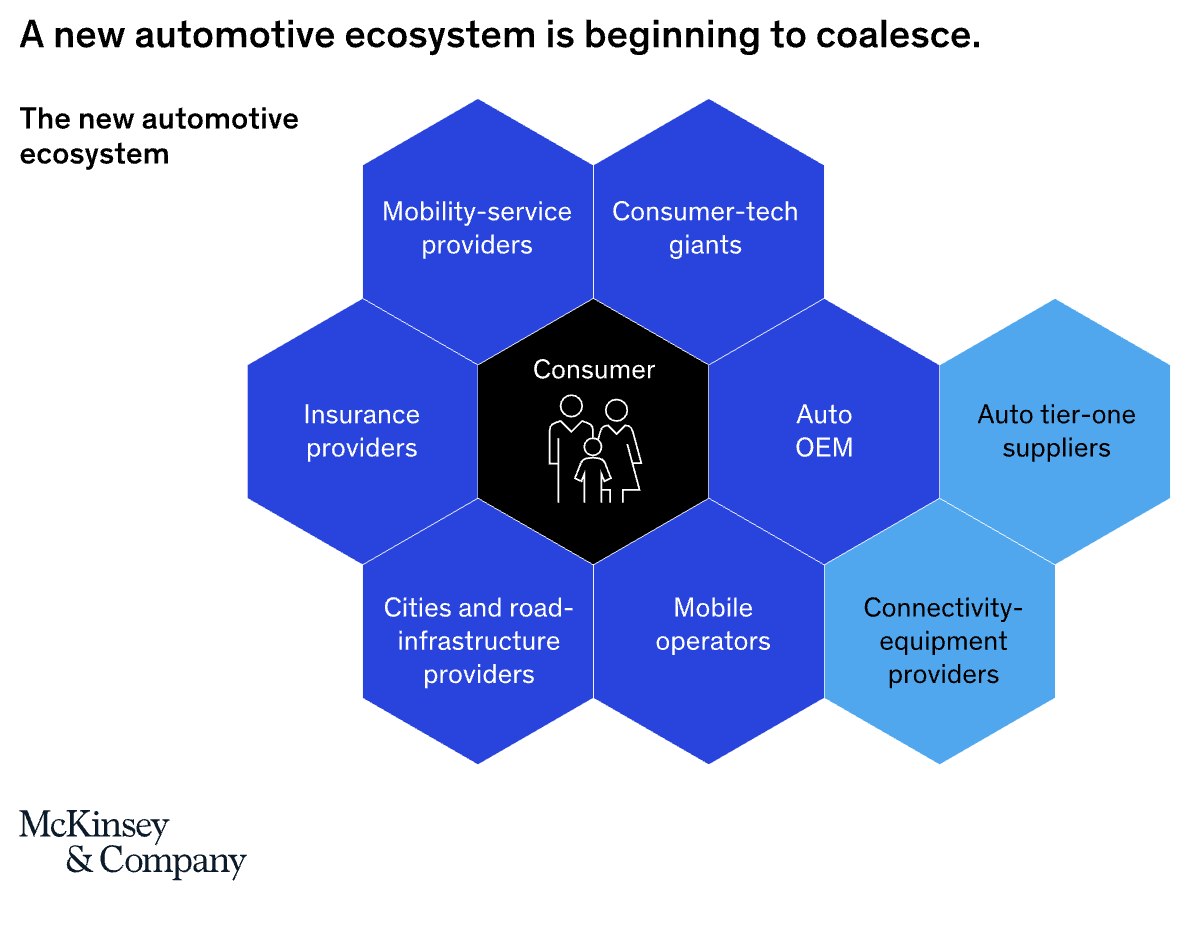
V2X, shorthand for Vehicle-to-Anything) is defined by McKinsey as follows:
Vehicle-to-vehicle (V2V) communications is the wireless transmission of data via dedicated short-range communications (DSRC) or cellular vehicle-to-everything (C-V2X) between vehicles. Its primary objective is to prevent accidents by allowing vehicles in transit to send data about vehicle position, road conditions and traffic conditions to one another over an ad hoc mesh network. Drivers may simply receive a warning, or the vehicle itself may take pre-emptive actions, such as braking to slow down in an automated way.
Today’s challenge is that we have two standards DSRC [802.11p] and C- V2X, which creates uncertainty in the industry. To make things worse, regulatory entities are not providing direction or guidance to mobility companies, further slowing down adoption.
Ubiquitous connectivity will facilitate automation and autonomy among cars on the road.

5G connectivity is the critical missing technology due to its wireless capacity and reliability, enabling vehicles to communicate with one another and the surrounding infrastructure. For example, a vehicle can warn about traffic incidents or road conditions can give early warnings to other drivers to help them avoid collisions. Vehicle-to-infrastructure (V2I) communication, where vehicles communicate with nearby infrastructure, such as traffic lights, road signals, and other transport infrastructure to further strengthen safety measures. For instance, a traffic light may alert the vehicle that it is turning red and the vehicle should adjust its speed. The last form of direct communication includes vehicle-to-pedestrian (V2P) communication, where the vehicle communicates with devices carried by pedestrians to ensure their safety. For instance, such devices might warn the vehicle that a pedestrian is on the walkway ahead. Furthermore, the ability of vehicles to communicate with one another could be used for innovative traffic management systems and help improve traffic flow.
Data Monetization and New Business Models
Smart City IoT Data Monetization
There are numerous opportunities to extract value from IoT data ranging from operational efficiencies, revenue growth for local businesses (and thus increase of taxes collected), cost savings and expense avoidance. Direct monetization of data can be achieved via providing paid data access, exchanges and licensing.

Public Transportation Revenue Streams
When connected, public transportation vehicles have the opportunity to deliver interior digital ads to passengers based on the exact demographic inside the vehicle. Such data can be extracted from the mobile app passengers use to summon and board the shuttle, the CPM value will be much higher. Such digital ads will be able to personalized and contextualized based on time of day and route, such as lunch special offers.
Exterior digital screens will also have dynamic advertising based on the shuttle route, and population profiles outside the shuttle. Based on my research and analysis at Fisker, the combination of in-mobile phone ads and offers, interior screens, and external facing displays can bring in as much as $35,000 ad revenue per year, off-setting the cost of ownership for the city.
It is crucial to plan such experiences, features and utility starting at the hardware design stage, as Henrik Fisker did for the Fisker ORBIT shuttle. Below are several monetization models for consideration:
When public transportation mobility solutions include robust technology, such as Microsoft Cortana assistant, which can adopt its voice via dialects and accents, creative marketers can transform such shuttles into sponsored branded experiences. Imagine Disney launching the new Frozen movie, and when passengers enter one of these shuttles, Cortana speaks as one of the movie characters. Such sponsored experiences can bring in as much as $120,000 per year, offesting the majority, if not the entire cost of such vehicle.
In summary, smart, autonomous, connected public transportation vehicles have the following monetization opportunities:
- Digital Network Smart-Ad Inventory Revenue Share. Ad revenue sharing for contextual, personalized, connected smart ads across various exterior and interior screens
- In-App sponsorships and 3rd party (commerce) integrations
- Various shuttle, customer, behavioral and app harvested data
- Loyalty programs with digital rewards
- Potential use cases for monetization and data include pay-per-use revenue sharing such as in-shuttle connectivity (Music / Jukebox, Skype Conferencing, Office, Xbox)
- Paid mobility subscriptions for passengers
- Ad to business location drop-off (sponsored stops, such as mandatory Wendy’s stop) where the vehicle literally drives business and modifies user behavior by effortlessly bringing customers to the doorsteps of businesses.
- Order a private shuttle
- Single ticket purchase (current business model)
Mobility App Data:
- Profile and demographic data
- GPS data
- In-app activity, content interests and actions taken on recommendations and promotions
- Extrapolated data: income (based where the phone “sleeps” and cross-referencing neighborhood home costs as means to estimate), lifestyle and interests based on geo-fencing locations frequently visited (such as a gym or school zones in the morning). Requires app location tracking to be permitted by the passenger
- Connected calendar / schedule analysis
- Preferences (music, windows up/down)
- Shuttle ride frequency, average ride time, human connections based on frequency of who you’re on board with
- Ingestion of social profile data
- “Social” to “DnD ratios (introvert / extrovert)
- Device capabilities, processing power, apps running
- DMP integration
Vehicle Data
- Vehicle performance and usage data (GPS, speed, # of stops, energy)
- Location overlays and spacial awareness data
- Charging profiles: where, when, time
- ECU / TCU / module and components data (brakes, motors, electrical, articulators, sensors, error codes, faults, incidents, logs)
- Integrated components / IOTs
- Training data for future autonomous models and new capabilities trainings
- Infotainment & passenger in-shuttle interactions data (personalized digital assistant usage, voice and gesture commands, gaming, UI interactions, purchases, browsing, productivity tools utilization)
- Environmental data such as ORBIT’s temperature, humidity, weather
- Time between destinations
- # of passengers on board
- Face & voice recognition
- Wifi usage and logs
Such data can be ingested into Data Management Platforms (DMPs) for
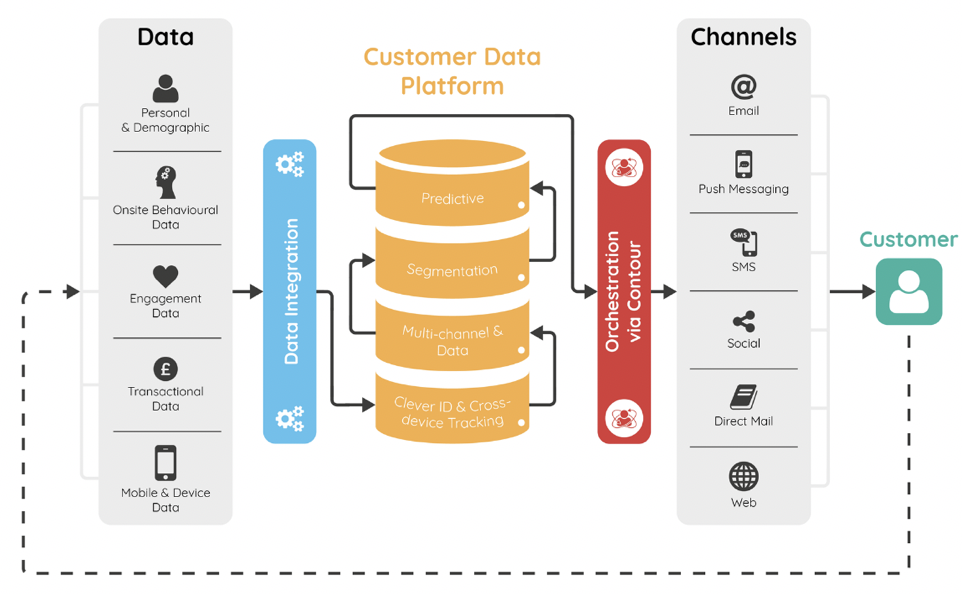
Mobility as a Service
Accenture research shows that by 2030, manufacturing revenues from vehicles sales will be flat to marginally higher than they are today, while profits will shrink, while revenues from mobility services will grow significantly to $1.33 trillion and $434B in profits. Mobility as a service is defined as digitally enabled car sharing:


Accenture breaks down the business models and revenue streams as follows:
Luxury Vehicle Manufacturer
Catering to the small, yet persistent market of customers who still want to own a car. This pure-play model will likely require the capability to establish a premium or even luxury brand, and to manufacture, market and sell cars of the highest quality.
B2B Asset Provider
Building, selling and servicing a new generation of “built-for-service” autonomous vehicles and delivering them to fleet providers; much as aircraft manufacturers build passenger planes for airlines. OEMs that take this route will likely have to shed their brand marketing operations and ramp up their flexible production capabilities.
Vehicle and Fleet Operator
OEMs would generate a circular economy effect that reduces waste and increases revenue potential by making, owning and operating all-inclusive vehicle fleets designed for an optimal lifecycle. More efficient vehicle use would reduce the costs of mobility services. And OEMs wouldn’t even need to own the services themselves to increase the lifetime efficiency of the vehicle; just all that stands behind them, end-to-end.
Car Mobility Service Provider
Essentially a scalable version of classic car-sharing, which, by generating more frequent customer interaction, provides valuable customer data insights. If OEMs were to monetize that data, leveraging strong partners to provide additional, location-based services, they could generate new car sales leads as well as improve the overall efficiency of vehicle use. A desirable option, but one that requires substantial brand investment to make it competitive.
Full Mobility Provider
By offering full mobility as a service, combining multiple modes of transportation, OEMs could act as mobility aggregators at the heart of
an inter-modal ecosystem, with partners including public transportation providers fully integrated into their brand. They would significantly broaden the scope of data and how it’s used, strengthening their grip on the user interface. The drawback: there would only be room for one or two dominant players in each market.

Digital Twins & Spatial Computing
Digital twins are virtual simulations of real-world physical assets. Data from IoTs allow us to run simulations and what-if scenarios for any given situation, such as disaster response, pollution control based on weather (wind, humidity and temperature), topology, traffic and industrial activity., crowd management, adaptive traffic and accident responses to name a few. This technology takes advantage of AI’s strength — crunching data and running optimizations, while humans remain focused on sense making.
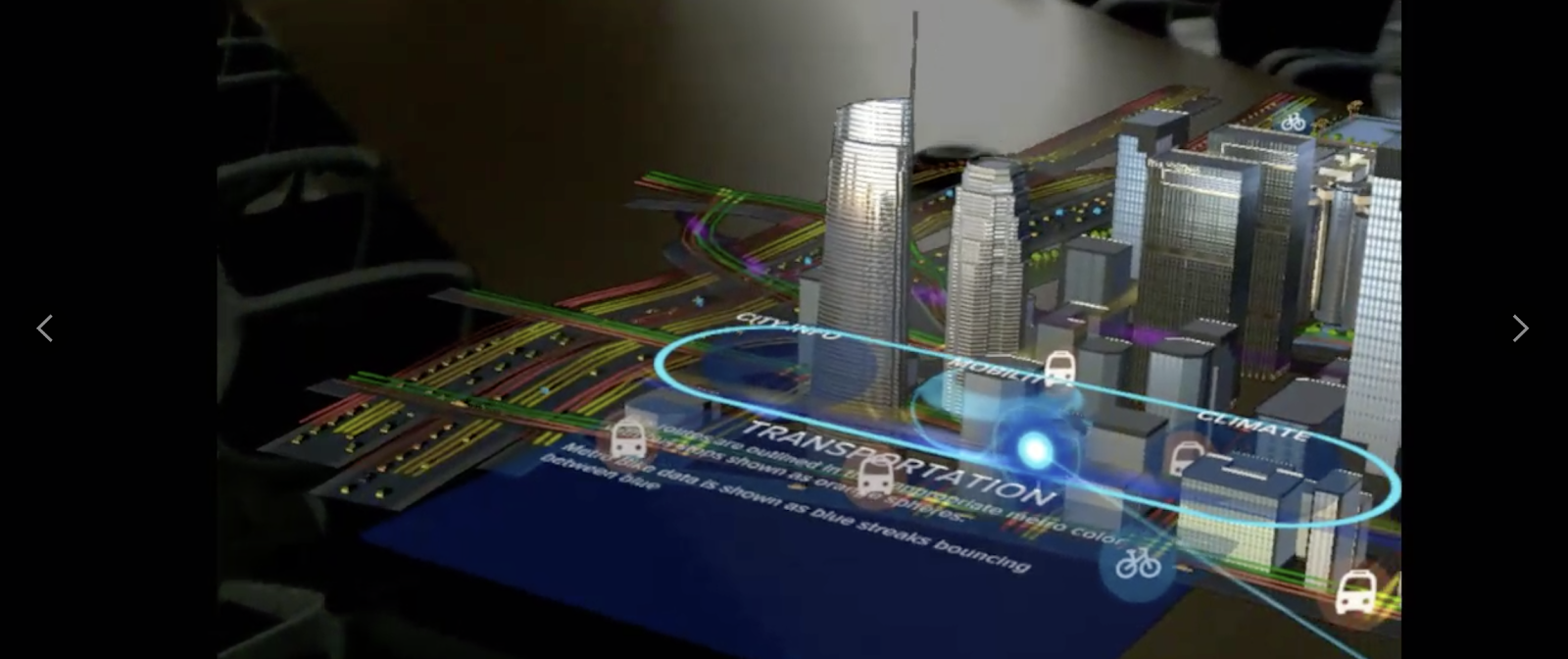
Technologies like Magic Leap and Microsoft HoloLens make this a(n augmented) reality, with spatial computing data visualization enabling humans to more effectively comprehend and act on the data. In the diagram below a city’s data is split into categorical data layers. During the 2019 Singularity Conference Magic Leap showed the full power of their platform:
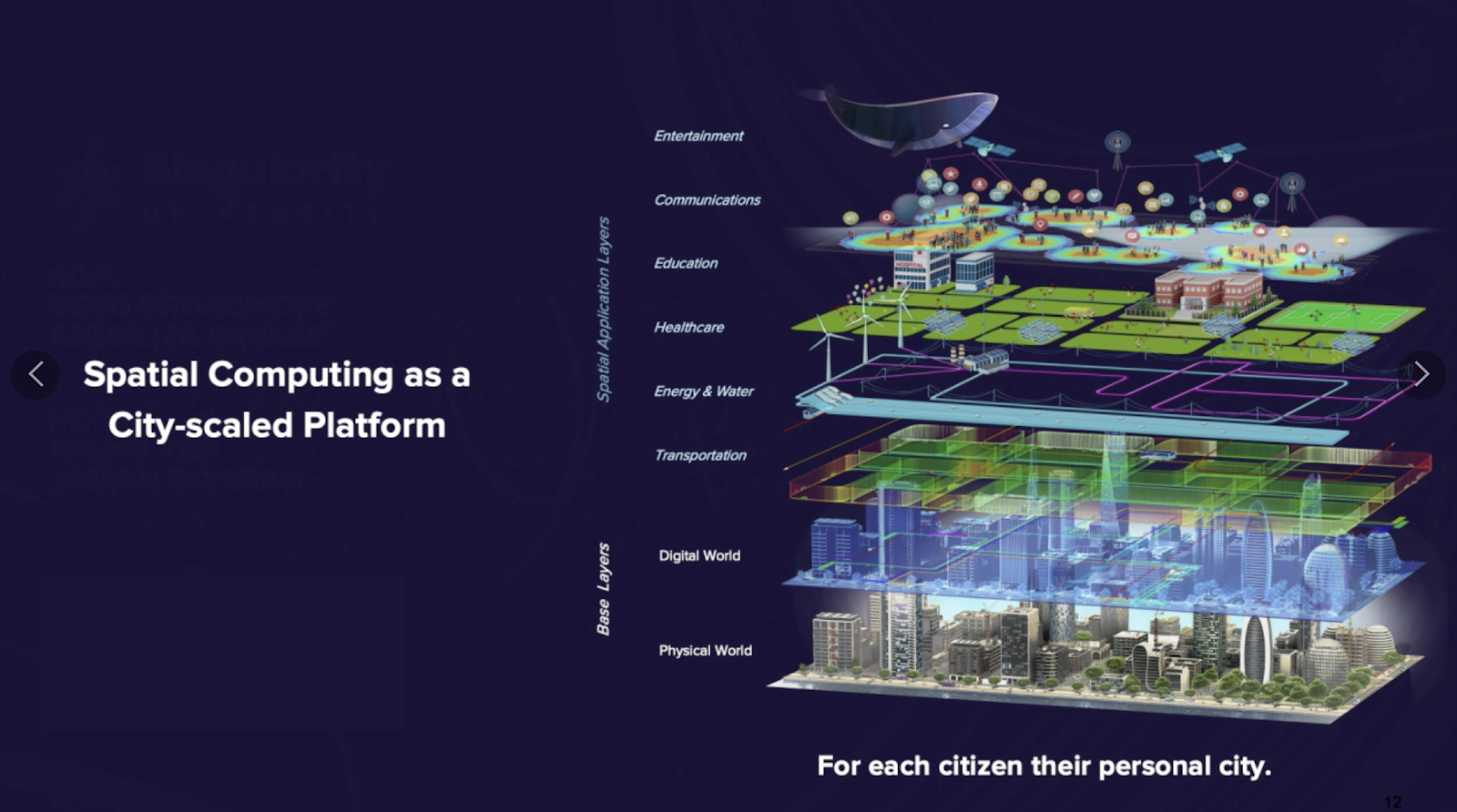
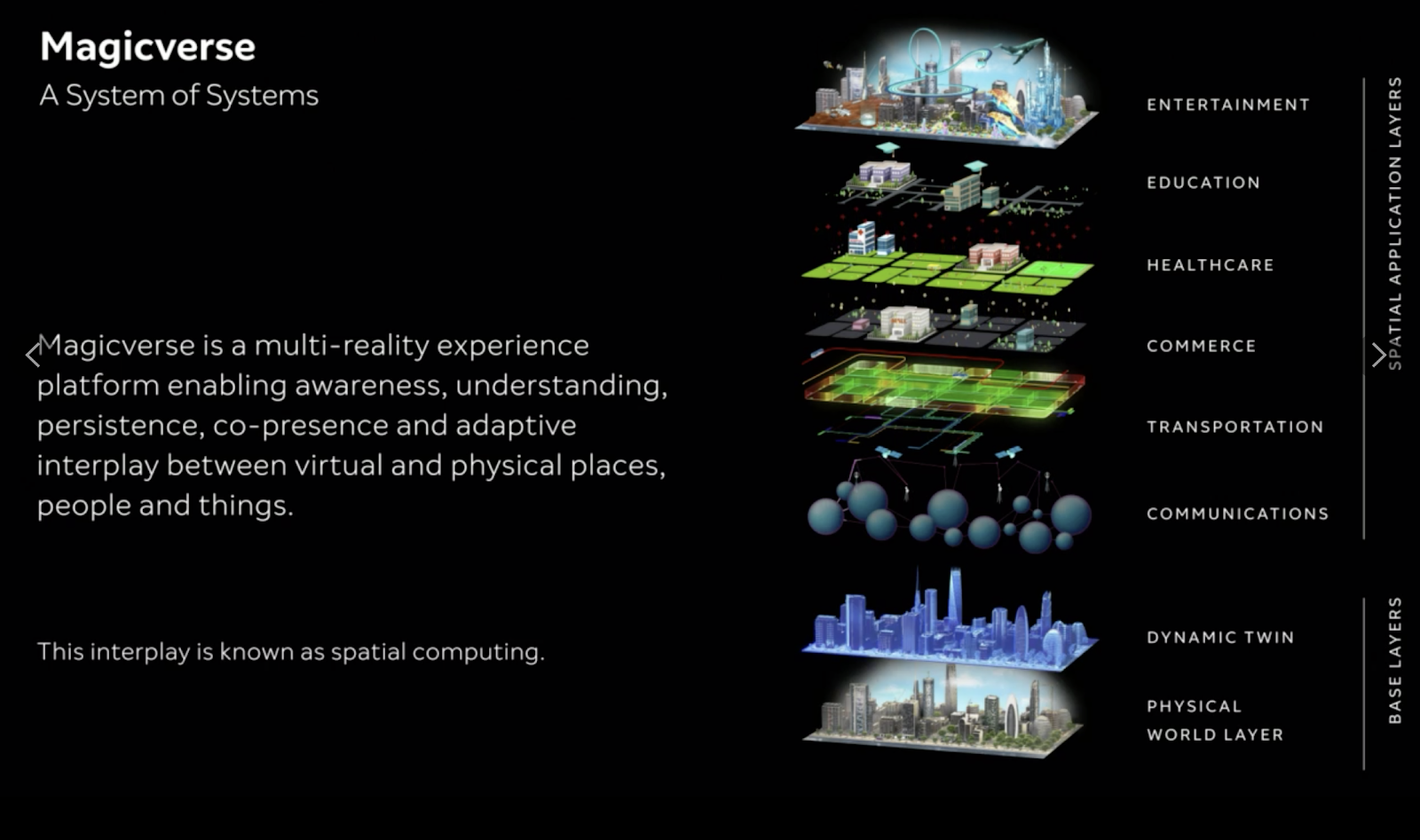

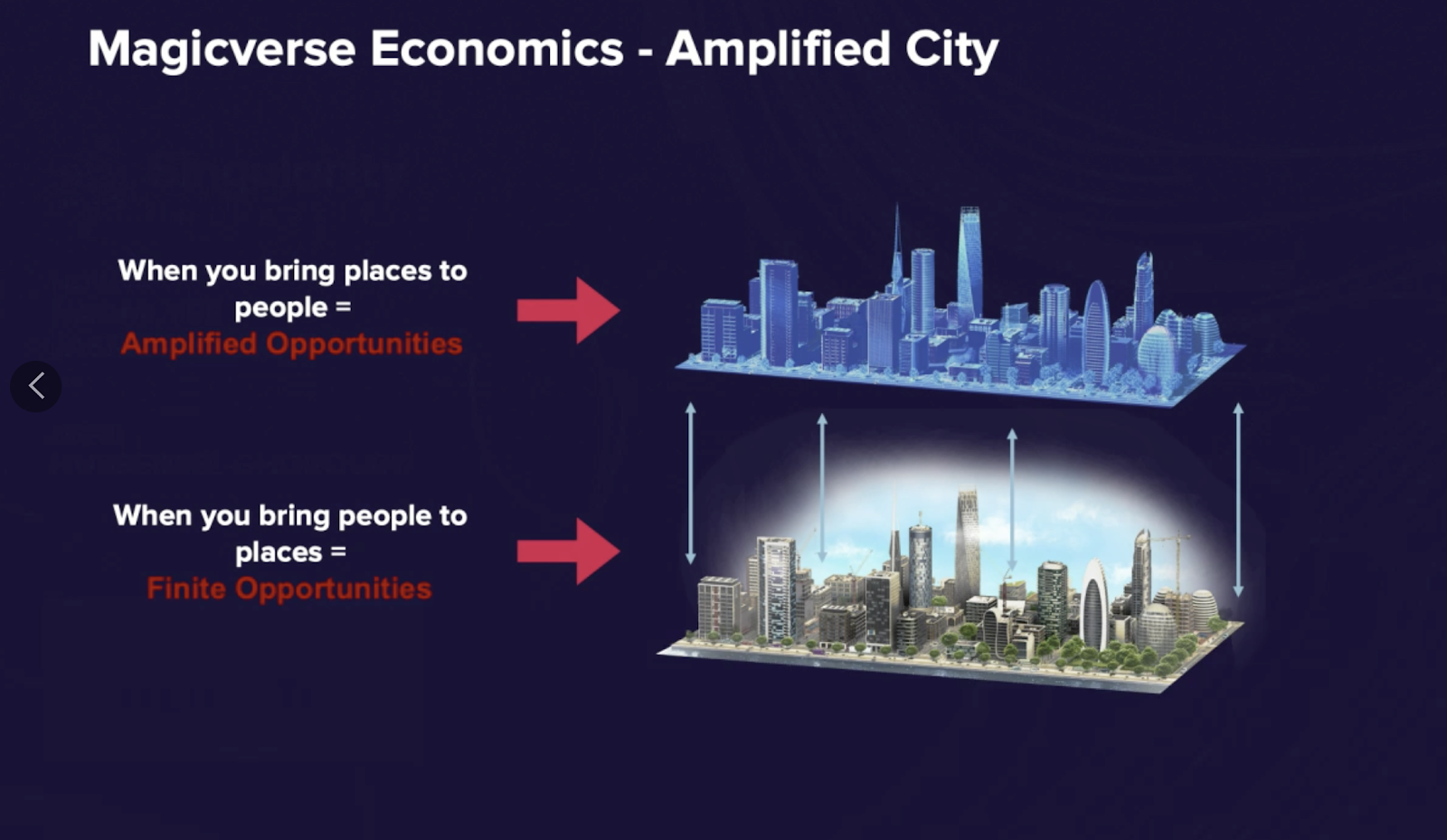
Microsoft is leading with such offering — as described on their blog: “With the application of cutting-edge technologies like Azure Digital Twins, which uses AI, Machine Learning, and IoT-enabled devices and services to develop a comprehensive digital model of a physical environment, cities can build efficient, intelligent infrastructures that leverage a highly secure and compliant cloud platform. Leveraging Azure Digital Twins enables cities to model, simulate, and analyze a wide variety of infrastructure data, including things like wastewater treatment, traffic flow, and social services. Empowered City leaders make data-driven decisions, and leverage analysis of massive amounts of data to create new policies using evidence-based impacts to proactively maintain systems, lower operational costs, and keep citizens happy. In addition, already, cities around the world make smart infrastructure choices today, using solutions like Microsoft’s Intelligent Public Works.”
Cloud Computing Frameworks for Smart Cities and Mobility
Microsoft and Amazon are ahead of the curve with many pre-built “starter” technologies and frameworks to enable autonomous mobility in smart city environments. Microsoft alone is investing 5B in IoT. Here is a summary of their “out of the box” capabilities:
Microsoft Azure Smart City Platform
When AI is coupled with IoTs, Microsoft Azure can help create new business value and social impact.


Microsoft’s “Building Smart Cities of the Future with Microsoft” blog post lists key examples enabled by smart city infrastructure, data and cloud connectivity that create value for the city and residents:
- Optimizing Public Transit — using ticket sales data to determine the level of service required during peak and low volume times and helps manage overcrowding popular routes and improve citizen satisfaction. These insights can save tax dollars by eliminating or rerouting underutilized routes, creating express routes or adjusting the frequency during low volume times to reduce emissions
- Enhancing communication. Not only do buses, trains, and other mass transit communicate with each other, public transit can notify commuters if it’s not on schedule to improve customer satisfaction. Alerting commuters of traffic congestion with real-time traffic monitoring through closed-circuit television cameras (CCTV) and AI-enabled apps can reduce commuter frustrations. Commuters can adjust schedules and take alternate routes or avoid driving by taking public transit.
- Increasing flow. Traffic signal timing can be adjusted for smoother traffic flow by analyzing traffic patterns by signal location, time of day, proximity to busy parking garages, or even providing citizens with a view of parking availability. Cities can also better manage factors such as the logistics of inbound freight and regulate things like double parking of delivery trucks during congested timeframes.
- Staying cleaner. Cities can stay cleaner when trash bins signal that they’re full. Sensors automatically send alerts when a specific weight of the bin is met. Sanitation can then respond when notified rather than creating roadblocks by picking up half-empty rubbish bins.
- Ensuring safety. Cities are safer when law enforcement can identify crime hot spots and respond more quickly to incidents. Streetlights with cameras can be activated by motion detectors rather than running continuously through the night.
Once connected, this vast network of devices empowers cities to generate the rich data required to apply artificial intelligence (AI) and uncover insights they can use to take action.
Amazon’s Smart City Platform
Amazon has also invested heavily in building up it’s cloud technology to serve as the backbone infrastructure for more sustainable cities of the future. Their vision is to integrate various data sources and design modern services starting with their pre-built technologies and ways to accelerate adoption.

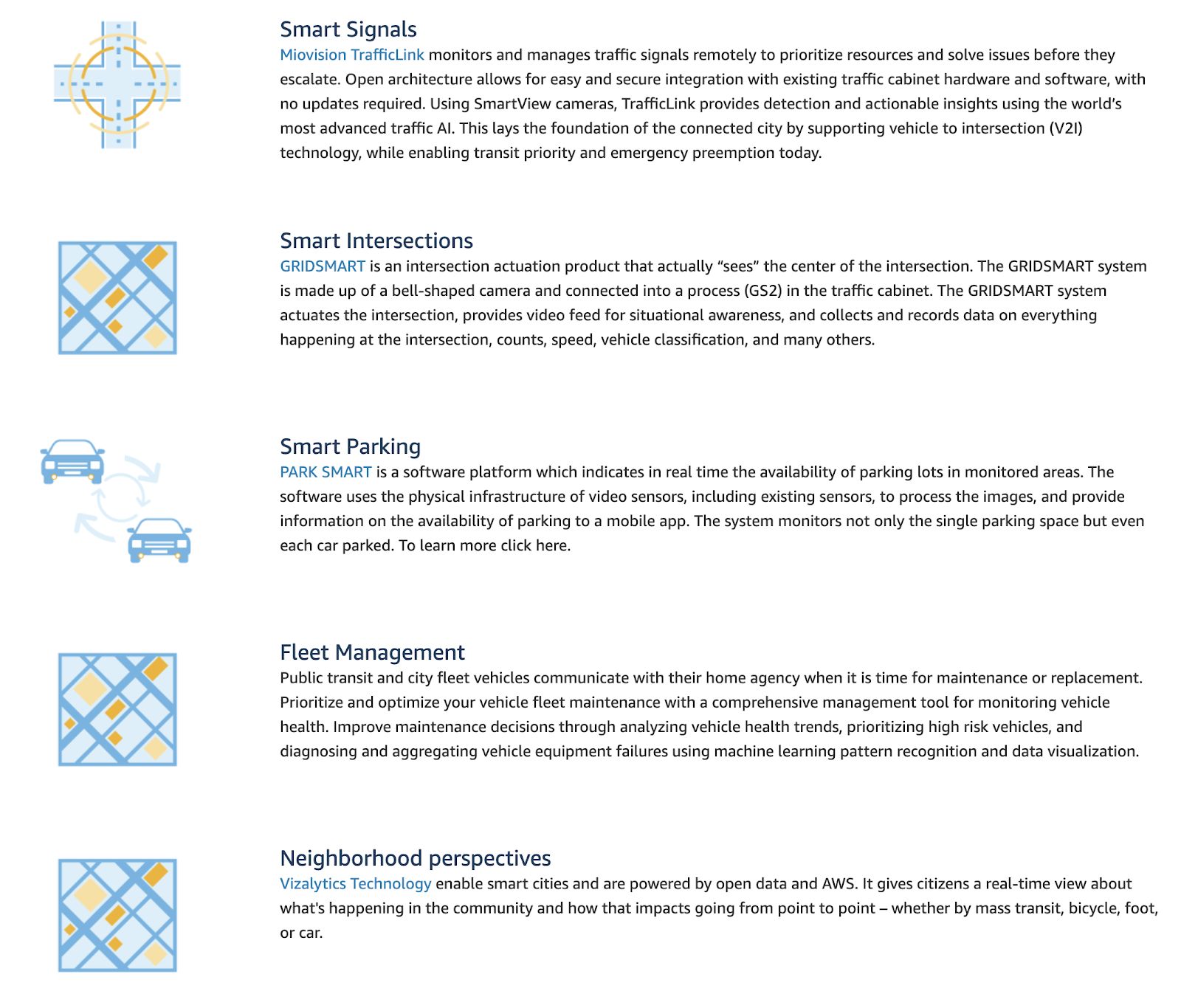
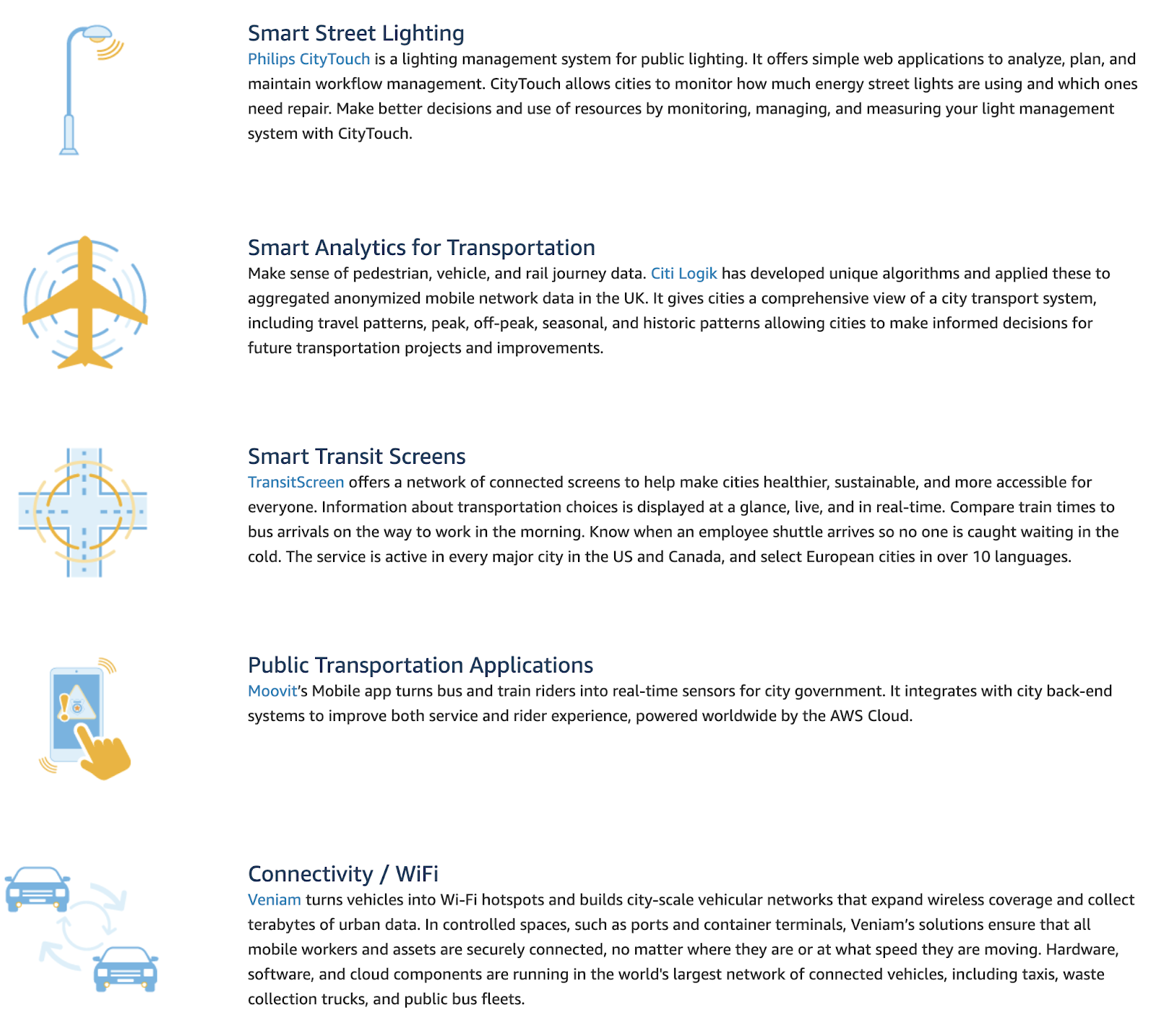



Amazon and Microsoft continue to mirror each other’s features and innovations in the smart city sector.
Prioritizing Efforts
Once smart cities fully connect infrastructure, business processes and people, incredible wealth of data will be generated and used to promote safety, efficiency, sustainability and economic growth. Gartner’s prioritization matrix (below) should be used by strategists and planners to prioritize efforts and investments.
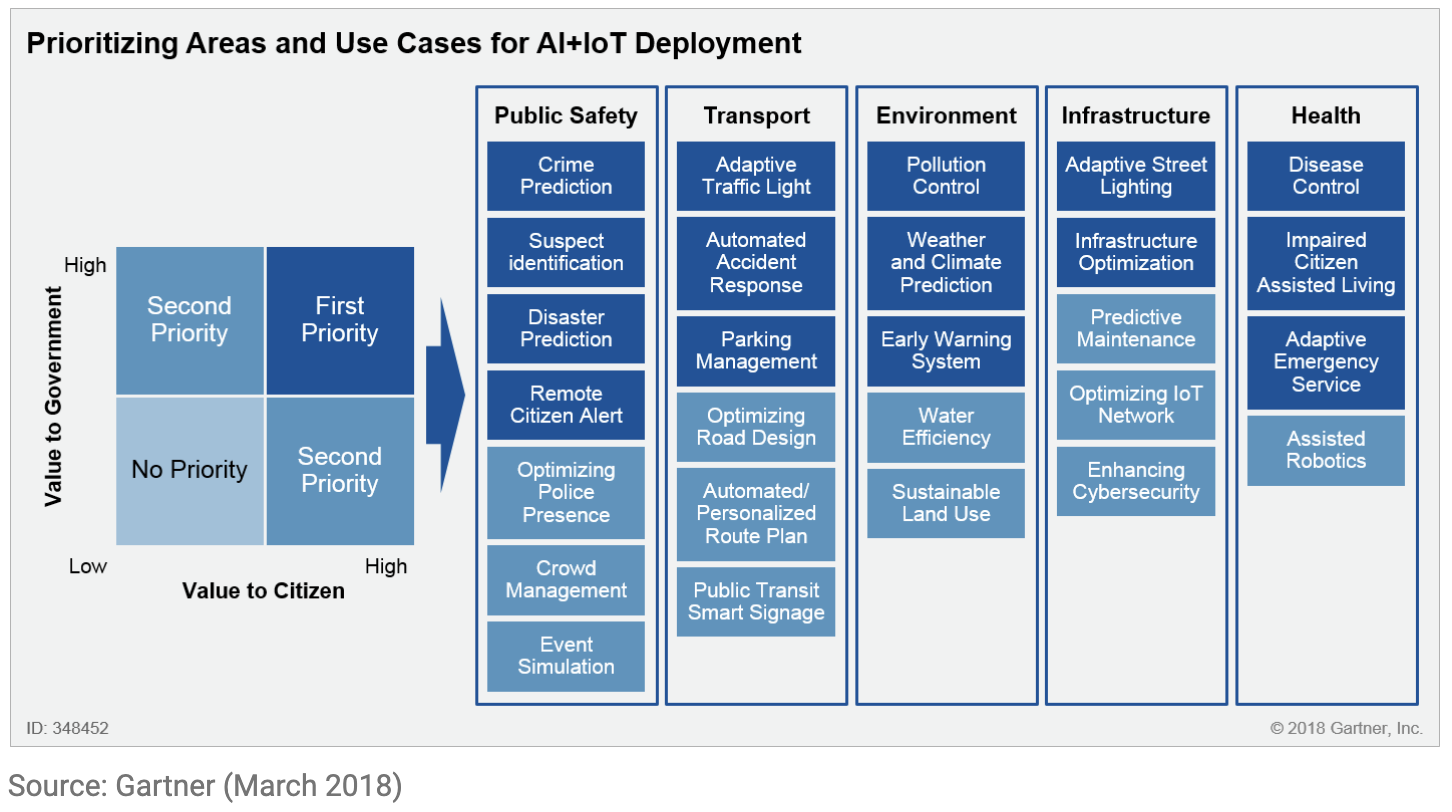
For technology leaders, Gartner recommends prioritizing the following trends:
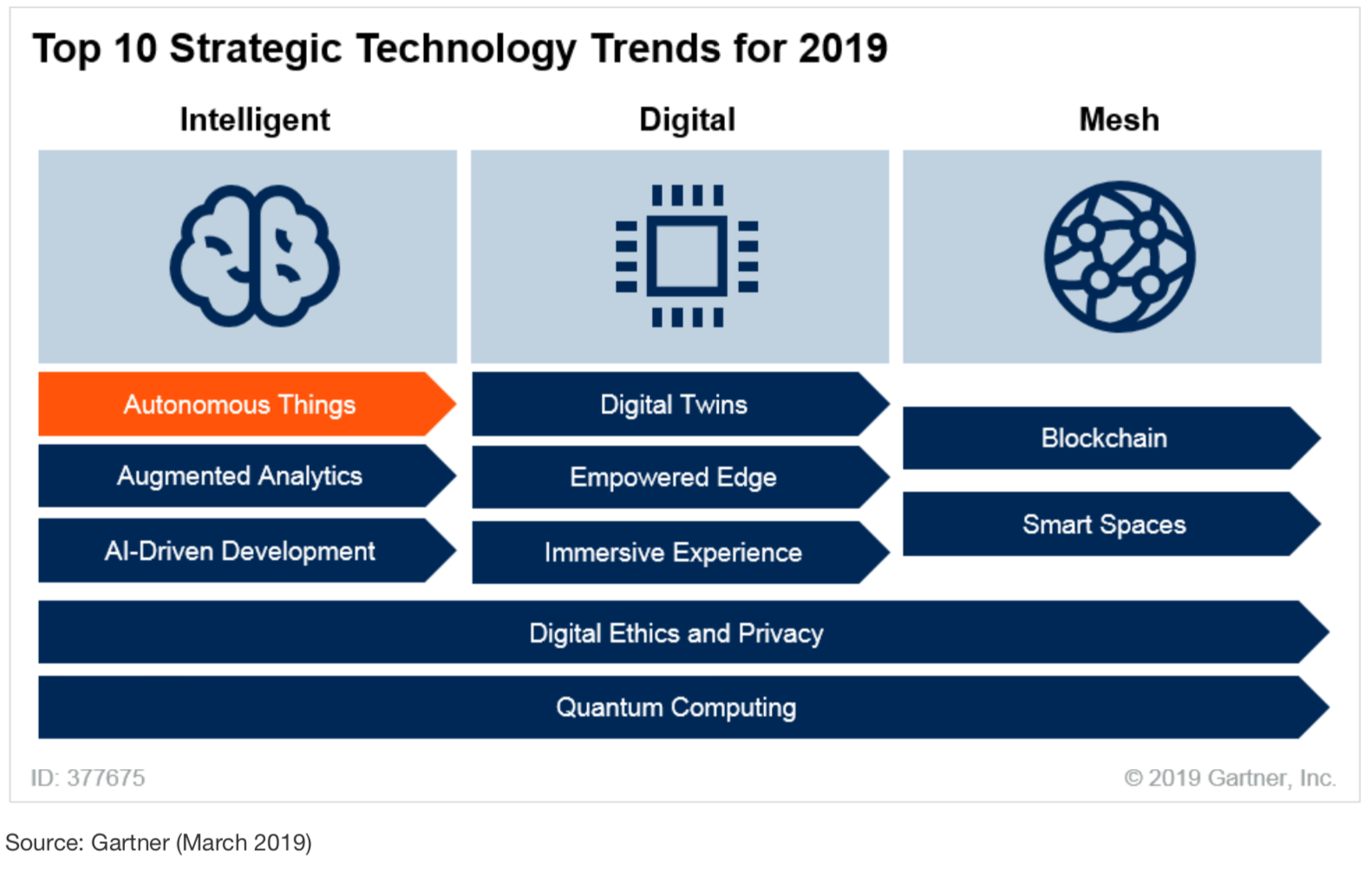
Our future is exciting.
Streetlight will wait longer for an old lady to cross, while also optimizing traffic patterns for optimal traffic throughput. Vehicle autonomy will remove the need for car insurance. Citizen will regain valuable time and use commute hours to learn, entertain, exercise, and even summon a (virtual) doctor in your Uber to diagnose you if you’re feeling sick.

Citations:
- Burke, Brian and Cearley, David “Top 10 Strategic Technology Trends for 2019: Autonomous Things,” Gartner, March 13, 2019, available from Gartner, accessed August 25th, 2019
- “Smart Cities: How 5G Can Help Municipalities Become Vibrant Smart Cities,” Accenture Strategy
- Burke, Brian and Cearley, David “Top 10 Strategic Technology Trends for 2019: Autonomous Things,” Gartner, March 13, 2019, available from Gartner, accessed August 25th, 2019
- Buytendijk, Frank & Tratz-Ryan, Bettina, “Digitopia 2035 Scenario: A Question of Convenience — How to Create More Digital Value,” Gartner, Aug. 21, 2019, available from Gartner, accessed August 25th, 2019
- Davenport, Jonathan “Hype Cycle for the Internet of Things, 2019,” Gartner, July 16, 2019, available from Gartner, accessed August 25th, 2019
- De Muynck, Bart and Johnson, John “Supply Chain Brief: Urban Delivery Robots Make Slow Progress in Drive for Last-Mile Delivery Solution,” Gartner, January 3, 2019, available from Gartner, accessed August 25th, 2019
- Empowering Automotive Innovation: Seizing the connected car opportunity with Microsoft ,” Microsoft, January 2017
- https://aws.amazon.com/automotive/autonomous-driving/
- https://aws.amazon.com/smart-cities/https://azure.microsoft.com/en-us/overview/iot/
- https://azure.microsoft.com/en-us/solutions/architecture/defect-prevention-with-predictive-maintenance/
- https://azure.microsoft.com/en-us/solutions/architecture/telemetry-analytics/
- https://cloudblogs.microsoft.com/dynamics365/bdm/2019/07/18/building-smart-cities-of-the-future-with-microsoft/
- https://cloudblogs.microsoft.com/industry-blog/government/2018/10/09/the-future-of-smart-cities-through-the-lens-of-urban-mobility/
- https://cloudblogs.microsoft.com/industry-blog/government/2018/10/16/step-into-a-new-era-of-public-service-with-smarter-infrastructure/
- https://discover.microsoft.com/powering-smart-cities-with-ai-and-iot/
- https://www.gartner.com/doc/reprints?id=1-4XYENKG&ct=180501&st=sb
- https://www.mckinsey.com/industries/automotive-and-assembly/our-insights/development-in-the-mobility-technology-ecosystem-how-can-5g-help
- https://www2.deloitte.com/us/en/insights/industry/automotive/augmented-reality-transportation-ecosystem-technologies.html?id=us:2em:3pa:future-of-mobility:eng:di:012919
- Mobility as a Service: Mapping a route towards future success in the new automotive ecosystem,” Accenture Strategy
- Sicular, Svetlana, J.H., K.B., “Hype Cycle for Artificial Intelligence, 2019,” Gartner, July 25, 2019, available from Gartner, accessed August 25th, 2019
- Williams, Roger and Davenport, Jonathan “Maverick* Research: Autonomous Mobile Structures Will Fuel the Sharing Economy,” Gartner, September 18, 2018, available from Gartner, accessed August 25th, 2019
- Woetzel, Jonathan, R.J., B.B., L.K., S.S., S.G., M.J., L.J., C.A., T.V., “Smart Cities: Digital Solutions for a more Livable Future,” McKinsey & Company, June 2018
- Yamaji, Masatsune “Hype Cycle for Automotive Electronics, 2019,” Gartner, July 15, 2019, available from Gartner, accessed August 25th, 2019
